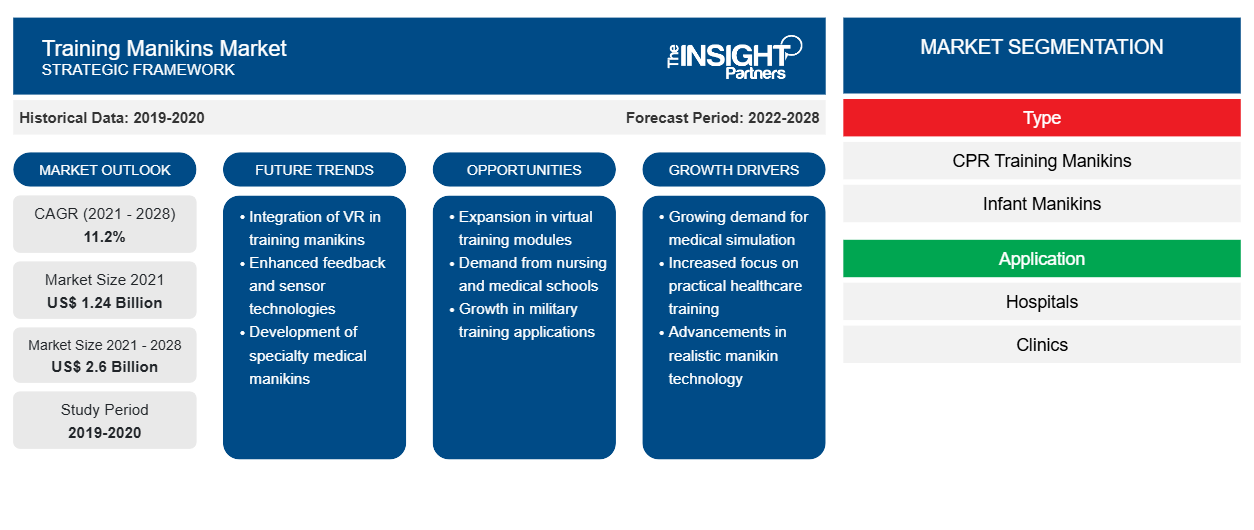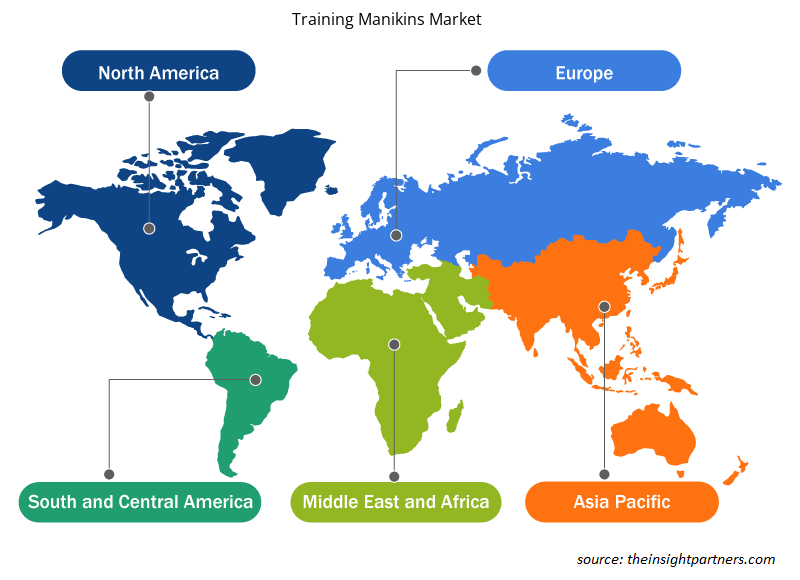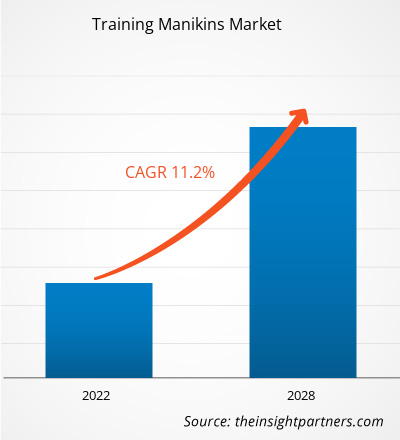Le marché des mannequins de formation devrait atteindre 9,15 milliards de dollars US d'ici 2031, contre 3,17 milliards de dollars US en 2024. Le marché devrait enregistrer un TCAC de 16,5 % entre 2025 et 2031. L'application de la robotique, de l'intelligence artificielle (IA) et de la réalité augmentée apparaît comme une tendance majeure sur ce marché.
Analyse du marché des mannequins de formation
Le marché des mannequins de formation devrait connaître une croissance substantielle dans les années à venir, en raison de la demande croissante en matière de formation aux soins de santé, de formation aux interventions d'urgence et de préparation militaire. Face à l'importance croissante accordée à l'apprentissage par simulation, les établissements médicaux et les centres de formation investissent dans des mannequins avancés offrant une anatomie et des réponses physiologiques réalistes. Le marché est stimulé par les avancées technologiques, telles que l'intégration de l'IA et les capacités sans fil, qui améliorent l'efficacité et l'interactivité des séances de formation. Les principaux acteurs se concentrent sur l'innovation produit, les partenariats stratégiques et l'expansion de leur présence géographique pour se démarquer de la concurrence. L'Amérique du Nord domine le marché grâce à une infrastructure de santé robuste et à des investissements importants dans la formation médicale. L'Asie-Pacifique connaît une croissance rapide, alimentée par le développement des systèmes de santé et une sensibilisation accrue à la RCP et à la formation en traumatologie.
Aperçu du marché des mannequins de formation
L'expansion du marché mondial des mannequins de formation est principalement tirée par les progrès des technologies de simulation, qui ont amélioré leur réalisme et leur efficacité. Ces mannequins sont désormais équipés de fonctionnalités telles que des structures anatomiques réalistes, des voies respiratoires réactives et des capteurs intégrés, facilitant une formation complète à diverses procédures médicales. La prévalence croissante des arrêts cardiaques extrahospitaliers (ACEH) et l'importance croissante accordée à la formation et à la sensibilisation à la RCP contribuent également à la croissance du marché. Selon les données de l'OMS publiées en 2020, le nombre de décès dus aux maladies coronariennes en France a atteint 63 181. Selon le Heart Failure Policy Network, cette maladie touchait environ un million de personnes en France. De plus, le taux de prévalence de l'insuffisance cardiaque atteint 10 % chez les personnes âgées de 70 ans et plus, et environ 120 000 personnes sont victimes d'infarctus chaque année dans le pays. Par conséquent, la demande de mannequins de formation est en hausse, compte tenu de l'attention croissante portée à la sécurité des patients et de la prévalence croissante des ACEH.
En août 2023, 3B Scientific, fabricant et fournisseur de premier plan de produits de simulation médicale et de modèles anatomiques pour l'enseignement médical, a acquis Lifecast Body Simulation afin de renforcer sa position sur le marché. En février 2023, Limbs & Things (Royaume-Uni) a signé un contrat de plusieurs millions de livres sterling avec TruCorp, une entreprise de simulation médicale basée en Irlande du Nord. Ce contrat fait de Limbs & Things le fournisseur exclusif des produits TruCorp au Royaume-Uni. De plus, l'utilisation du réseau établi de Limbs & Things renforcerait la capacité de TruCorp à proposer ses innovations très demandées sur ces marchés.
Personnalisez ce rapport en fonction de vos besoins
Vous bénéficierez d'une personnalisation gratuite de n'importe quel rapport, y compris des parties de ce rapport, ou d'une analyse au niveau des pays, d'un pack de données Excel, ainsi que de superbes offres et réductions pour les start-ups et les universités.
Marché des mannequins de formation : perspectives stratégiques

-
Obtenez les principales tendances clés du marché de ce rapport.Cet échantillon GRATUIT comprendra une analyse de données, allant des tendances du marché aux estimations et prévisions.
Facteurs moteurs et opportunités du marché des mannequins de formation
Les progrès technologiques stimulent la croissance du marché
Les mannequins de formation ont considérablement évolué en termes de technologie et de complexité. Ils sont désormais équipés de systèmes sophistiqués simulant avec précision les fonctions physiologiques humaines. Ce développement permet aux formateurs d'offrir aux cliniciens des opportunités d'apprentissage, de pratique et de maîtrise de leurs compétences pour des procédures simples comme très complexes, notamment diagnostiques et thérapeutiques, telles que l'accouchement, les soins respiratoires, les traitements cardiovasculaires, les interventions neurologiques, la modélisation pharmacologique et la simulation. Ces mannequins sont conçus pour créer et permettre aux participants de pratiquer des procédures telles que la réanimation cardio-pulmonaire, l'intubation, la ventilation au ballon-masque, la défibrillation et la pose d'un drain thoracique.
CAE Santé a développé des modèles et des simulateurs pour diverses procédures, incluant des mannequins allant des mannequins néonatals aux mannequins adultes. Par exemple, le simulateur de patient humain (HPS) est un mannequin de formation complet conçu pour Healthcare has developed models and simulators for various procedures; these include products ranging from neonatal to adult manikins. For instance, the human patient simulator (l'anesthésie et l'administration de gaz médicaux, avec une modélisation respiratoire, neurologique, cardiovasculaire et pharmacologique brevetée. Il s'agit de la référence en matière de simulation patient haute fidélité pour la formation en soins respiratoires et intensifs. Le HPS s'interface avec de véritables moniteurs cliniques et respirateurs, et réagit automatiquement à l'administration de gaz anesthésiques réels, d'oxygénothérapie et de médicaments. Lucina, autre mannequin de formation essentiel, est un simulateur d'accouchement sans fil intégrant la physiologie materno-fœtale et des services statiques interchangeables pour former les apprenants à toutes les étapes de l'accouchement et aux scénarios d'urgence rares. Le mannequin Lucina permet de démontrer des processus d'accouchement réalistes et contrôlables, allant des scénarios d'accouchement normal à diverses complications, comme la dystocie des épaules et l'éclampsie, et offre une excellente articulation pour les manœuvres de travail et d'accouchement.HPS) is a full-body training manikin created to support HPS interfaces with real clinical monitors and ventilators, and automatically responds to administration of real anesthetic gases, oxygen therapy, and drugs/medications. Lucina, another crucial training manikin, is a wireless childbirth simulator with incorporated maternal-fetal physiology and interchangeable static services to train the learners on all delivery stages and rare emergency scenarios. The Lucina manikin comes with an ability to demonstrate realistic, controllable birthing processes from normal delivery scenarios to various birth complications, including shoulder dystocia and eclampsia, and great articulation for labor and delivery maneuvers.
Laerdal propose des mannequins et simulateurs de formation pour tous les âges, de l'adulte au nourrisson. Le SimMan 3G est un simulateur patient portable et facile à utiliser, conçu pour la formation en équipe. Il présente une anatomie et des fonctionnalités cliniques réalistes. Il offre un enseignement basé sur la simulation pour mettre à l'épreuve les compétences cliniques et décisionnelles des étudiants lors de scénarios de soins réalistes. De plus, les mannequins Nursing Anne, Nursing Kelly, Crash Kelly et Harvey proposés par Laerdal sont conçus pour la formation clinique en gynécologie, obstétrique, évaluation et soins des plaies, pose de sonde gastrique, entraînement cardio-pulmonaire et gestion avancée des voies aériennes. Par conséquent, le développement de produits grâce aux innovations technologiques renforce le marché des mannequins de formation.
Nombre croissant d'initiatives stratégiques visant à créer des opportunités de croissance
Les petites et grandes entreprises opérant sur le marché des mannequins de formation adoptent de plus en plus de stratégies pour accroître leurs revenus. Voici quelques développements récents sur ce marché :
- En décembre 2024, Safeguard Medical, pionnier des produits de traumatologie et de simulation médicale, a lancé le mannequin SIMBODIES Pro, un modèle de pointe. Conçu pour résister aux environnements d'entraînement les plus exigeants, des zones de combat aux centres de traumatologie à haute pression, le mannequin SIMBODIES Pro est le dernier-né de la gamme de mannequins d'entraînement hyperréalistes SIMBODIES. Développé en collaboration avec l'armée américaine, le mannequin SIMBODIES Pro est spécialement conçu pour répondre aux exigences exigeantes de l'entraînement de niveau professionnel, garantissant un réalisme et une durabilité exceptionnels dans diverses conditions de terrain, que ce soit par forte chaleur ou par températures glaciales.
- En février 2024, IngMar Medical a présenté Aurora, un mannequin de simulation médicale avancé conçu pour former les cliniciens à tous les aspects de la ventilation. Doté du nouveau poumon interne simulé (ISL), Aurora utilise la technologie exclusive de simulation respiratoire ASL 5000 d'IngMar, élevant ainsi le niveau de formation médicale. Le mannequin Aurora maintient efficacement les niveaux thérapeutiques de PEEP (pression expiratoire positive) et démontre une respiration spontanée sous ventilation, garantissant ainsi aux professionnels de santé une préparation optimale à une multitude de scénarios de ventilation.
- En août 2023, 3B Scientific a acquis Lifecast Body Simulation. Lifecast a développé une gamme de mannequins médicaux très précis et réalistes qui révolutionnent la manière dont la simulation et l'enseignement médicaux sont dispensés et compris.
Par conséquent, la participation active des acteurs du marché aux lancements de produits, aux extensions, aux partenariats et aux fusions et acquisitions crée des opportunités de croissance lucratives sur le marché des mannequins de formation.
Analyse de segmentation du rapport sur le marché des mannequins de formation
Les segments clés qui constituent la base de l’analyse du marché des mannequins de formation sont le type, l’application, la tranche d’âge et l’utilisateur final.
- Selon le type, le marché des mannequins de formation se divise en mannequins de formation à la réanimation cardio-pulmonaire (RCP), aux soins infirmiers, aux soins d'urgence, aux soins généraux et aux réanimation cardio-pulmonaire (RCP), entre autres. En 2024, le segment des mannequins de formation à la RCP détenait la plus grande part de marché.
En termes d'application, le marché des mannequins de formation est segmenté en soins intensifs, obstétrique-gynécologie, cardiologie, pneumologie, etc. Le segment de la cardiologie a dominé le marché en 2024.
- En fonction de la tranche d'âge, le marché des mannequins de formation est segmenté en mannequins adultes, mannequins pédiatriques et mannequins néonatals. Le segment des mannequins adultes détenait la plus grande part de marché en 2024.
- Par utilisateur final, le marché est divisé en écoles de médecine et salles de classe communautaires, hôpitaux, cliniques et autres. Le segment des écoles de médecine et des salles de classe communautaires détenait la plus grande part de marché des mannequins de formation en 2024.
Analyse des parts de marché des mannequins d'entraînement par zone géographique
La portée géographique du rapport sur le marché des mannequins de formation est divisée en cinq régions : Amérique du Nord, Asie-Pacifique, Europe, Moyen-Orient et Afrique, et Amérique du Sud et centrale.
L'Amérique du Nord détenait une part importante du marché en 2024. Les avancées technologiques ont permis le développement de mannequins haute fidélité équipés de capteurs, d'IA et de capacités de réalité virtuelle (RV), renforçant le réalisme de la formation médicale et améliorant les résultats des apprenants. De plus, l'importance croissante accordée à l'apprentissage par simulation dans l'enseignement des soins de santé a stimulé la demande d'outils de formation réalistes, les établissements cherchant à réduire les erreurs médicales et à améliorer la préparation des professionnels de santé. Les organismes de réglementation et d'accréditation imposent également l'intégration de la formation par simulation dans les programmes médicaux. Par ailleurs, les entreprises du marché des mannequins de formation adoptent des stratégies de croissance, telles que le lancement de produits innovants, qui favorisent la croissance du marché. En juillet 2022, AHead Simulations, une entreprise canadienne, a lancé un mannequin universel avancé, baptisé CARL, doté d'une tête multifonctionnelle. Le mannequin audio CARL a été développé par AHead Simulations après plusieurs années de recherche, de validation et de multiples itérations. Il a été fabriqué directement à partir de scanners de patients et est doté d'oreilles souples réalistes facilement remplaçables.
Aperçu régional du marché des mannequins de formation
Les tendances régionales et les facteurs influençant le marché des mannequins de formation tout au long de la période de prévision ont été analysés en détail par les analystes d'Insight Partners. Cette section aborde également les segments et la géographie du marché des mannequins de formation en Amérique du Nord, en Europe, en Asie-Pacifique, au Moyen-Orient et en Afrique, ainsi qu'en Amérique du Sud et en Amérique centrale.

- Obtenez les données régionales spécifiques au marché des mannequins de formation
Portée du rapport sur le marché des mannequins de formation
| Attribut de rapport | Détails |
|---|---|
| Taille du marché en 2024 | 3,17 milliards de dollars américains |
| Taille du marché d'ici 2031 | 9,15 milliards de dollars américains |
| TCAC mondial (2025 - 2031) | 16,5% |
| Données historiques | 2021-2023 |
| Période de prévision | 2025-2031 |
| Segments couverts |
Par type
|
| Régions et pays couverts |
Amérique du Nord
|
| Leaders du marché et profils d'entreprises clés |
|
Densité des acteurs du marché des mannequins de formation : comprendre son impact sur la dynamique des entreprises
Le marché des mannequins de formation connaît une croissance rapide, portée par une demande croissante des utilisateurs finaux, due à des facteurs tels que l'évolution des préférences des consommateurs, les avancées technologiques et une meilleure connaissance des avantages du produit. Face à cette demande croissante, les entreprises élargissent leur offre, innovent pour répondre aux besoins des consommateurs et capitalisent sur les nouvelles tendances, ce qui alimente la croissance du marché.
La densité des acteurs du marché désigne la répartition des entreprises opérant sur un marché ou un secteur particulier. Elle indique le nombre de concurrents (acteurs) présents sur un marché donné par rapport à sa taille ou à sa valeur marchande totale.
Les principales entreprises opérant sur le marché des mannequins de formation sont :
- Ambu A/S,
- Gaumard Scientific Co Inc.,
- Laerdal Medical AS,
- Simulaids Ltd,
- Erler-Zimmer GmbH & Co. KG,
- Nasco Santé,
Avertissement : Les entreprises répertoriées ci-dessus ne sont pas classées dans un ordre particulier.

- Obtenez un aperçu des principaux acteurs du marché des mannequins de formation
Actualités et développements récents du marché des mannequins de formation
Le marché des mannequins de formation est évalué en collectant des données qualitatives et quantitatives issues d'études primaires et secondaires, incluant des publications d'entreprises importantes, des données d'associations et des bases de données. Voici quelques-unes des évolutions du marché :
- Laerdal Medical, leader mondial des solutions de simulation en santé, a dévoilé son partenariat de distribution mondial exclusif avec SIMCharacters, une entreprise autrichienne pionnière spécialisée dans les technologies de simulation néonatale de pointe. Ce partenariat stratégique marque une étape importante dans l'évolution de la simulation en santé et souligne notre engagement commun à révolutionner la formation médicale. (Source : Laerdal Medical, communiqué de presse, janvier 2024)
- CliniSim, une marque de Simulaids Ltd, a lancé FGM Care Aware pour aider les professionnels de santé à détecter et diagnostiquer les mutilations génitales féminines (MGF) lors de la conférence de simulation médicale ASPiH à Édimbourg. Ce produit a été conçu et fabriqué en collaboration avec une grande école de médecine britannique afin de faciliter la formation et la sensibilisation à cette pratique qui touche plus de 200 millions de personnes dans le monde. (Source : Simulaids, communiqué de presse, novembre 2024)
Rapport sur le marché des mannequins de formation : couverture et livrables
Le rapport « Taille et prévisions du marché des mannequins de formation (2021-2031) » fournit une analyse détaillée du marché couvrant les domaines ci-dessous :
- Taille et prévisions du marché des mannequins de formation aux niveaux mondial, régional et national pour tous les segments de marché clés couverts par le champ d'application
- Tendances du marché des mannequins de formation et dynamiques du marché telles que les facteurs déterminants, les contraintes et les opportunités clés
- Analyse PEST et SWOT détaillée
- Analyse du marché des mannequins de formation couvrant les principales tendances du marché, le cadre mondial et régional, les principaux acteurs, les réglementations et les développements récents du marché
- Analyse du paysage industriel et de la concurrence couvrant la concentration du marché, l'analyse de la carte thermique, les principaux acteurs et les développements récents sur le marché des mannequins de formation
- Profils d'entreprise détaillés
- Analyse historique (2 ans), année de base, prévision (7 ans) avec TCAC
- Analyse PEST et SWOT
- Taille du marché Valeur / Volume - Mondial, Régional, Pays
- Industrie et paysage concurrentiel
- Ensemble de données Excel
Rapports récents
Témoignages
Raison d'acheter
- Prise de décision éclairée
- Compréhension de la dynamique du marché
- Analyse concurrentielle
- Connaissances clients
- Prévisions de marché
- Atténuation des risques
- Planification stratégique
- Justification des investissements
- Identification des marchés émergents
- Amélioration des stratégies marketing
- Amélioration de l'efficacité opérationnelle
- Alignement sur les tendances réglementaires






















 Obtenez un échantillon gratuit pour - Marché des mannequins de formation
Obtenez un échantillon gratuit pour - Marché des mannequins de formation